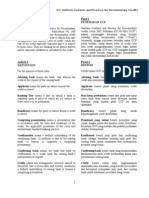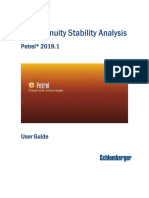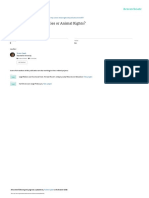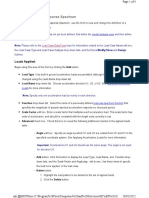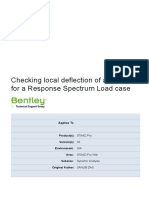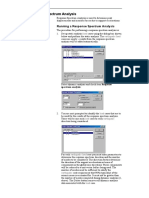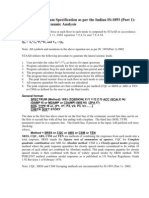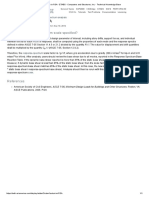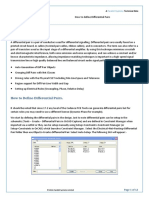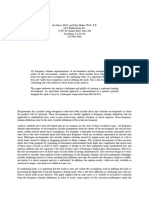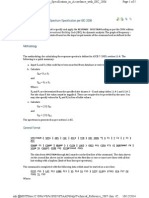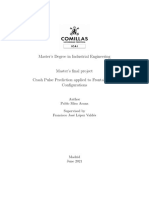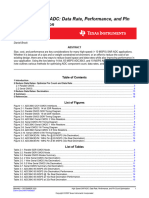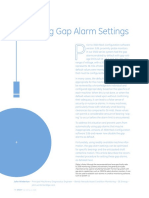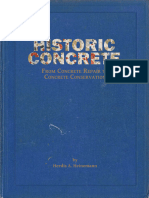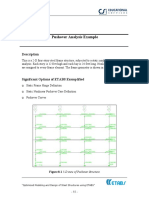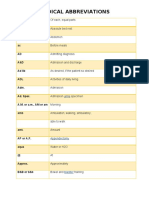0 ratings0% found this document useful (0 votes)
72 viewsTorsional Irregularities Check For Response Spectrum Analysis (RSA) - ETABS - Computers and Structures, Inc. - Technical Knowledge Base
Torsional Irregularities Check For Response Spectrum Analysis (RSA) - ETABS - Computers and Structures, Inc. - Technical Knowledge Base
Uploaded by
O STorsional Irregularities check for Response Spectrum Analysis (RSA) - ETABS - Computers and Structures, Inc. - Technical Knowledge Base
Copyright:
© All Rights Reserved
Available Formats
Download as PDF, TXT or read online from Scribd
Torsional Irregularities Check For Response Spectrum Analysis (RSA) - ETABS - Computers and Structures, Inc. - Technical Knowledge Base
Torsional Irregularities Check For Response Spectrum Analysis (RSA) - ETABS - Computers and Structures, Inc. - Technical Knowledge Base
Uploaded by
O S0 ratings0% found this document useful (0 votes)
72 views2 pagesTorsional Irregularities check for Response Spectrum Analysis (RSA) - ETABS - Computers and Structures, Inc. - Technical Knowledge Base
Original Title
Torsional Irregularities check for Response Spectrum Analysis (RSA) - ETABS - Computers and Structures, Inc. - Technical Knowledge Base
Copyright
© © All Rights Reserved
Available Formats
PDF, TXT or read online from Scribd
Share this document
Did you find this document useful?
Is this content inappropriate?
Torsional Irregularities check for Response Spectrum Analysis (RSA) - ETABS - Computers and Structures, Inc. - Technical Knowledge Base
Copyright:
© All Rights Reserved
Available Formats
Download as PDF, TXT or read online from Scribd
Download as pdf or txt
0 ratings0% found this document useful (0 votes)
72 views2 pagesTorsional Irregularities Check For Response Spectrum Analysis (RSA) - ETABS - Computers and Structures, Inc. - Technical Knowledge Base
Torsional Irregularities Check For Response Spectrum Analysis (RSA) - ETABS - Computers and Structures, Inc. - Technical Knowledge Base
Uploaded by
O STorsional Irregularities check for Response Spectrum Analysis (RSA) - ETABS - Computers and Structures, Inc. - Technical Knowledge Base
Copyright:
© All Rights Reserved
Available Formats
Download as PDF, TXT or read online from Scribd
Download as pdf or txt
You are on page 1of 2
General Topics SAP2000 CSiBridge ETABS SAFE PERFORM-3D CSiCOL Tutorials Test Problems Documentation
Licensing
Dashboard / Home / Response-spectrum analysis
Torsional Irregularities check for Response Spectrum Analysis (RSA)
Created by Faisal Habib, last modified by Truly Guzman on Aug 05, 2019
How can torsional irregularities be calculated for response-spectrum analysis?
Answer: For a given direction of acceleration, the maximum displacements, forces, and stresses are computed throughout the structure for each vibration mode.
Modal values for a given response quantity are combined to produce a single, positive result for the given direction of acceleration using one of the modal
combination methods (CQC, SRSS, or ABS). In a response-spectrum case, the results computed represent a statistical measure of the likely maximum magnitude
for a given response quantity. The actual response is expected to vary within a range from this positive value to its negative. No correspondence is made between
two different response quantities. Further, no information is available as to when extreme values occur.
To compute Torsional Irregularity and Extreme Torsional Irregularity, as specified in ASCE 7-05 Table 12.3-1, item 1a and 1b must be performed according to
modes, and not the response-spectrum case. These irregularities in turn can trigger requirements for Torsional amplification of seismic loads. Steps are given as
follows:
1. Obtain the scaling for each mode as the response-spectrum modal amplitude through Display > Show Tables > Analysis > Results > Modal Results >
Response Spectrum Modal Information:
Figure 1 - Table: Response Spectrum Modal Information
2. Select Define > Load Combinations > Add New Combo. Select Modal in drop down list under Load Name and enter Mode number and Scale factor for the
specific mode from Response Spectrum Modal information Table as given in item 1. Add each mode in a separate load combination, as shown in Figure 2:
Figure 2 - Load combination data
3. Obtain joint displacements for each mode per item 2 by selecting Display > Show Tables > Tables> Analysis > Results> Displacements> Joint
Displacements.
4. Compute the average story drift at two ends of the building, then compare with the maximum story drift for that specific mode i.e. Dmax/Dav<1.2 or 1.4 for
each mode.
5. Combine all modes using the SRSS or ABS method to determine whether Torsional Irregularity or Extreme Torsional Irregularity is applicable to the model.
For example: SQRT[SUM(Dmax/Dav)^2]<(1.2 or 1.4)xSQRT(number of modes).
Refer also to related watch and learn video below:
ETABS - 26 Accidental Torsion: Watch …
complete torsional-irregularity response-spectrum
torsional-amplification etabs rsa
Copyright © 2020 Computers and Structures, Inc. All rights reserved. | Powered by Atlassian
You might also like
- UCP 600 (Bilingual Version)Document40 pagesUCP 600 (Bilingual Version)HendraImaSasmita85% (27)
- Ameco-Beijing-Benefits-of-Performance-Appraisals 2 PDFDocument12 pagesAmeco-Beijing-Benefits-of-Performance-Appraisals 2 PDFRadowankhanNo ratings yet
- Glazyev Sergei - The Last World War - The US To Move and LoseDocument501 pagesGlazyev Sergei - The Last World War - The US To Move and LoseO S100% (1)
- Harold Hillman, Peter Sartory - The Living Cell - A Re-Examination of Its Fine Structure (1980, Packard)Document116 pagesHarold Hillman, Peter Sartory - The Living Cell - A Re-Examination of Its Fine Structure (1980, Packard)O SNo ratings yet
- Automated Broad and Narrow Band Impedance Matching for RF and Microwave CircuitsFrom EverandAutomated Broad and Narrow Band Impedance Matching for RF and Microwave CircuitsNo ratings yet
- Autopipe Msrs Example1XzDocument29 pagesAutopipe Msrs Example1XzFabio Miguel100% (1)
- SALOME Meca Code Aster AbbreviationsDocument36 pagesSALOME Meca Code Aster AbbreviationsCostynha100% (1)
- DSA Petrel2019 1 UserManualDocument17 pagesDSA Petrel2019 1 UserManualAdi Danu SaputraNo ratings yet
- Ryan Mackey - On Debunking 9/11 DebunkingDocument313 pagesRyan Mackey - On Debunking 9/11 DebunkingMfdrr0% (1)
- Animal Law: Human Duties or Animal Rights?: October 2020Document47 pagesAnimal Law: Human Duties or Animal Rights?: October 2020Gabriel FloreaNo ratings yet
- Torsional Irregularities Check For Response Spectrum Analysis (RSA) - ETABS - Computers and Structures, Inc. - Technical Knowledge BaseDocument3 pagesTorsional Irregularities Check For Response Spectrum Analysis (RSA) - ETABS - Computers and Structures, Inc. - Technical Knowledge BaseO SNo ratings yet
- Torsional Irregularities Check For Response Spectrum Analysis (RSA)Document2 pagesTorsional Irregularities Check For Response Spectrum Analysis (RSA)rahulNo ratings yet
- Torsional Irregularities Check in ETABSDocument3 pagesTorsional Irregularities Check in ETABSRahmanNo ratings yet
- Load Case Data - Response Spectrum: Loads AppliedDocument4 pagesLoad Case Data - Response Spectrum: Loads AppliedFares ShawadfyNo ratings yet
- User Interface: Create New Load Items Dialog Response Spectra TabDocument7 pagesUser Interface: Create New Load Items Dialog Response Spectra TabYashu HandaNo ratings yet
- Ants Technical Paper Esd Delta System HGSTDocument7 pagesAnts Technical Paper Esd Delta System HGSTapi-374884793No ratings yet
- Entries M ODocument46 pagesEntries M OXiaohui ChenNo ratings yet
- Models.sme.Bracket Random VibrationDocument24 pagesModels.sme.Bracket Random VibrationSerhat TüysüzNo ratings yet
- ASSET Technical Reference GuideDocument82 pagesASSET Technical Reference GuidenupongNo ratings yet
- Checking Local Deflection of A Member For A Response Spectrum Load CaseDocument4 pagesChecking Local Deflection of A Member For A Response Spectrum Load CaseBilal A Barbhuiya100% (1)
- Scale Factor in RSA - ETABS - Computers and Structures, IncDocument1 pageScale Factor in RSA - ETABS - Computers and Structures, IncronyNo ratings yet
- Microstran EquarkeloadDocument6 pagesMicrostran Equarkeloadshantanu chowdhuryNo ratings yet
- Scaling of Base Shear in ETABSDocument19 pagesScaling of Base Shear in ETABSmohammed100% (2)
- CDEGS Quick Guide PDFDocument28 pagesCDEGS Quick Guide PDFrian0201No ratings yet
- Quick Guide On Cdegs CRDocument28 pagesQuick Guide On Cdegs CRGilberto MejíaNo ratings yet
- PowerSwingDetection TestingMethodologyDocument6 pagesPowerSwingDetection TestingMethodologybaskaranjay5502No ratings yet
- An Integrated Approach To Random Analysis Using MSC/PATRAN With MSC/NASTRANDocument23 pagesAn Integrated Approach To Random Analysis Using MSC/PATRAN With MSC/NASTRANmijobitoNo ratings yet
- Staad Response SpectrumDocument5 pagesStaad Response Spectrumturbobrik0% (1)
- TP Master 2 SAR ATRDocument4 pagesTP Master 2 SAR ATRKhaled LechhebNo ratings yet
- Computing DAFs Single Jackup LegDocument10 pagesComputing DAFs Single Jackup LegPrasanth VarrierNo ratings yet
- Den CharDocument11 pagesDen CharReidacocadapreta100% (1)
- Protection CoordinationDocument4 pagesProtection CoordinationdiestefanoNo ratings yet
- Response Spectrum Specification As Per ISCODEDocument5 pagesResponse Spectrum Specification As Per ISCODESaphal LamichhaneNo ratings yet
- A Technical Note: Parallel SystemsDocument13 pagesA Technical Note: Parallel SystemsAlexNo ratings yet
- Apdl in WorkbechDocument14 pagesApdl in Workbechkiran_wakchaureNo ratings yet
- Scale Factor in RSA - ETABS - Computers and Structures, IncDocument1 pageScale Factor in RSA - ETABS - Computers and Structures, Incsathiyaseelann.sNo ratings yet
- CM2 CFS100 2002 04Document32 pagesCM2 CFS100 2002 04Akmal ZuhriNo ratings yet
- AC Simulation: August 2005Document24 pagesAC Simulation: August 2005Aichetou ElkhadarNo ratings yet
- Diffpairs DefinitionDocument12 pagesDiffpairs DefinitionHr ReferralNo ratings yet
- KISSsoft Tutorial 010 Gearlifetime enDocument22 pagesKISSsoft Tutorial 010 Gearlifetime enkarayagizmuhammedNo ratings yet
- Protective Device Coordination - ETAPDocument12 pagesProtective Device Coordination - ETAPMiguel CbNo ratings yet
- Seismic Load Calculation Example Problems Answers PDF PrintableDocument4 pagesSeismic Load Calculation Example Problems Answers PDF PrintableomarNo ratings yet
- Nastran Errors ListDocument1,297 pagesNastran Errors ListMubeenNo ratings yet
- SB 345000 ParametersDocument32 pagesSB 345000 ParametersTadej Fabčič100% (1)
- ASSET 8.0 Technical Reference GuideDocument6 pagesASSET 8.0 Technical Reference Guidesondang123No ratings yet
- Lab 2a Dynamic Response of A Mass-Spring System With DampingDocument5 pagesLab 2a Dynamic Response of A Mass-Spring System With DampingPrashant AshishNo ratings yet
- SORA_bhawk_tech_paperDocument11 pagesSORA_bhawk_tech_paperVOLDE SINGHNo ratings yet
- Response Spectrum Analysis As Per StaadDocument5 pagesResponse Spectrum Analysis As Per StaadprabhuNo ratings yet
- Site Name:: L0352ATONSU - ETDocument12 pagesSite Name:: L0352ATONSU - ETNyonyo Korshie LotsuNo ratings yet
- Fatigue Analysis Using CAESAR IIDocument7 pagesFatigue Analysis Using CAESAR IIayounga100% (1)
- Master ThesisDocument115 pagesMaster Thesiskap8185No ratings yet
- Site Name:: L0302CEDARDocument12 pagesSite Name:: L0302CEDARNyonyo Korshie LotsuNo ratings yet
- Fatigue in Ls-DynaDocument13 pagesFatigue in Ls-DynaYyy UuuNo ratings yet
- Tutorial 11 CompositeDCB Delamination V5 1Document16 pagesTutorial 11 CompositeDCB Delamination V5 1UdhamNo ratings yet
- EE214B: Folded CascodeDocument11 pagesEE214B: Folded CascodeNeil Hildick-SmithNo ratings yet
- Project Report 834 - 200502321Document21 pagesProject Report 834 - 200502321Vasu GoswamiNo ratings yet
- STMicroelectronics M4T28 BR12SH1 Datasheet PDFDocument13 pagesSTMicroelectronics M4T28 BR12SH1 Datasheet PDFHernan Vallenilla Rumildo MixNo ratings yet
- 2022 Hybrid System Description TemplateDocument13 pages2022 Hybrid System Description TemplateHuaiming HuNo ratings yet
- TarDocument8 pagesTarLe Huyen Vu MyNo ratings yet
- Sbaa 461Document17 pagesSbaa 461scriptbabyNo ratings yet
- Using Generic Data To Establish Dormancy Failure Rates: Bruce ReistleDocument6 pagesUsing Generic Data To Establish Dormancy Failure Rates: Bruce ReistleYianni Hudon-CastilloNo ratings yet
- Optimizing Gap Alarm Settings: ApplicationsDocument5 pagesOptimizing Gap Alarm Settings: ApplicationsAymanKFUPMNo ratings yet
- 1 IF-THEN-ELSE Construct: NOAA/National Weather Service/OHD Scientific Algorithm Description StandardDocument5 pages1 IF-THEN-ELSE Construct: NOAA/National Weather Service/OHD Scientific Algorithm Description StandardANIL KSNo ratings yet
- Backpropagation: Fundamentals and Applications for Preparing Data for Training in Deep LearningFrom EverandBackpropagation: Fundamentals and Applications for Preparing Data for Training in Deep LearningNo ratings yet
- Power Systems-On-Chip: Practical Aspects of DesignFrom EverandPower Systems-On-Chip: Practical Aspects of DesignBruno AllardNo ratings yet
- Analog Dialogue Volume 46, Number 1: Analog Dialogue, #5From EverandAnalog Dialogue Volume 46, Number 1: Analog Dialogue, #5Rating: 5 out of 5 stars5/5 (1)
- Heinemann Historic Concrete From Concrete Repair To Concrete ConservationDocument560 pagesHeinemann Historic Concrete From Concrete Repair To Concrete ConservationO SNo ratings yet
- Gi Ukepr Ce 02Document74 pagesGi Ukepr Ce 02O SNo ratings yet
- (MANUAL) RspMatchEDT - User's ManualDocument92 pages(MANUAL) RspMatchEDT - User's ManualO SNo ratings yet
- Rilem TC 162-Tdf: Test and Design Methods For Steel Fibre Reinforced ConcreteDocument4 pagesRilem TC 162-Tdf: Test and Design Methods For Steel Fibre Reinforced ConcreteO SNo ratings yet
- Patently-Obvious China-AstraZenecaDocument7 pagesPatently-Obvious China-AstraZenecaO SNo ratings yet
- (PAPER) Stancu M Borcia I S (1999) Studies Concerning Directionality of Seismic Action For Vrancea EarthquakesDocument10 pages(PAPER) Stancu M Borcia I S (1999) Studies Concerning Directionality of Seismic Action For Vrancea EarthquakesO SNo ratings yet
- (PAPER) Gazetas G., Hess P., Zinn R. Mylonakis G., Nikolaou A. (1998) Seismic Response of A Large Pile Group - Paris 1998Document11 pages(PAPER) Gazetas G., Hess P., Zinn R. Mylonakis G., Nikolaou A. (1998) Seismic Response of A Large Pile Group - Paris 1998O SNo ratings yet
- (Extract) CSI - Steel Structures - Example VIII Pushover Analysis ExampleDocument5 pages(Extract) CSI - Steel Structures - Example VIII Pushover Analysis ExampleO SNo ratings yet
- (EXTRACT) Etabs Analysis Reference v18 - Friction Pendulum - Single, Double & TripleDocument13 pages(EXTRACT) Etabs Analysis Reference v18 - Friction Pendulum - Single, Double & TripleO SNo ratings yet
- Redo Log FileDocument15 pagesRedo Log FileammaraNo ratings yet
- Levinas HopeDocument15 pagesLevinas HopeTrismegisteNo ratings yet
- Research Paper Topics Human Growth DevelopmentDocument5 pagesResearch Paper Topics Human Growth Developmentfysfs7g3No ratings yet
- Pricing, Pricing Strategy and Pricing Pyramid PresentationDocument10 pagesPricing, Pricing Strategy and Pricing Pyramid PresentationGildas MemevegniNo ratings yet
- Effects of Hydrotherapy in Balance and Prevention of Falls Among Elderly WomenDocument60 pagesEffects of Hydrotherapy in Balance and Prevention of Falls Among Elderly WomenThermalBathsforActivNo ratings yet
- Preeti Singh Design of A Point of Care Device ForDocument10 pagesPreeti Singh Design of A Point of Care Device ForDavron EshtursunovNo ratings yet
- Double Spherical Pendulum PDFDocument28 pagesDouble Spherical Pendulum PDFcrguntalilibNo ratings yet
- Deed of Extra Judicial Settlement With DonationDocument3 pagesDeed of Extra Judicial Settlement With DonationRolandStaMariaNo ratings yet
- A G T F C B D: Uidance OOL OR Ircular Uilding EsignDocument22 pagesA G T F C B D: Uidance OOL OR Ircular Uilding EsignsafiradhaNo ratings yet
- Rainbow Capitalism: Chidambara AgrawalDocument3 pagesRainbow Capitalism: Chidambara AgrawalChidambara AgrawalNo ratings yet
- Pinto pm5 Inppt 02Document35 pagesPinto pm5 Inppt 02ShantalNo ratings yet
- Origins and Dynamics of Culture, Society and Political IdentitiesDocument17 pagesOrigins and Dynamics of Culture, Society and Political IdentitiesKate Andrea Millan100% (1)
- Mini-Lesson 3 Ethical and Legal Mini-LessonDocument2 pagesMini-Lesson 3 Ethical and Legal Mini-Lessonapi-674346530No ratings yet
- Laguna State Polytechnic University: Professor: Dr. Lucita G. Subillaga Reporter: Jean Paul V. Banay - M.A.Ed. - E.MDocument4 pagesLaguna State Polytechnic University: Professor: Dr. Lucita G. Subillaga Reporter: Jean Paul V. Banay - M.A.Ed. - E.MRyan Paul NaybaNo ratings yet
- Question Words American English StudentDocument3 pagesQuestion Words American English StudentShiela DichosNo ratings yet
- Rev. 1 FLEXIBLE LEARNING TEMPLATE 1Document7 pagesRev. 1 FLEXIBLE LEARNING TEMPLATE 1Rolando Cruzada Jr.No ratings yet
- Indy Oil Field Development Plan PDFDocument139 pagesIndy Oil Field Development Plan PDFMohamed Yousry100% (1)
- Chapter 13Document55 pagesChapter 13g-08221486No ratings yet
- First Law of MotionDocument2 pagesFirst Law of MotionCharlie WilliamsonNo ratings yet
- Medical Abbreviations: Aa ABR Abd. Ac AD A&D Ad Lib ADL Adm. Ad. Spec. A.M. or A.m., AM or Am Morning AmbDocument10 pagesMedical Abbreviations: Aa ABR Abd. Ac AD A&D Ad Lib ADL Adm. Ad. Spec. A.M. or A.m., AM or Am Morning AmbAriaNo ratings yet
- Somatoform DisorderDocument3 pagesSomatoform DisorderJunar M. BalasbasNo ratings yet
- Sprite - An Innovative Product LaunchDocument23 pagesSprite - An Innovative Product LaunchdiyasiddhuNo ratings yet
- Math 4THDocument8 pagesMath 4THDarnell Raymundo CapurasNo ratings yet
- All About Business Letter Aug 15Document3 pagesAll About Business Letter Aug 15Enzo IgnacioNo ratings yet
- PatriotsDocument3 pagesPatriotsca3No ratings yet
- Semester 2, 2020 Week 8: Data Mining in WEKA Tutorial/Lab Session - 7Document13 pagesSemester 2, 2020 Week 8: Data Mining in WEKA Tutorial/Lab Session - 7Tiarana PakaNo ratings yet
